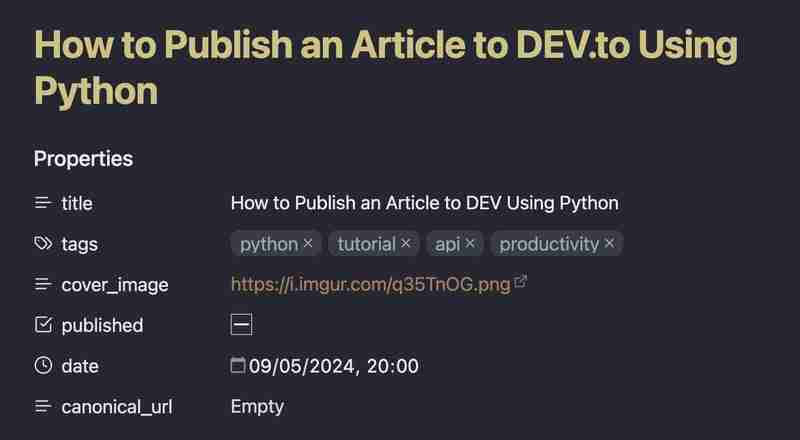
記事を書くために Obsidian を定期的に使用している私は、Markdown コンテンツを手動で DEV.to に公開するのは時間がかかることに気づきました。これを合理化するために、DEV.to に直接公開するプロセスを自動化する Python スクリプトを開発しました。このガイドでは、Python と DEV.to API を使用して記事公開ワークフローを簡素化する方法を説明します。
コードに入る前に、次のものが必要です:
• DEV API キー: DEV アカウントにログインし、API キー セクションに移動することで、これを生成できます。
• Python がインストールされています: システムに Python 3.x がインストールされていることを確認してください。
プロセスを 3 つのステップに分けて説明します:
以下は、記事を DEV に公開するプロセスを自動化するための完全な Python スクリプトです。
import webbrowser
import requests
import json
# API headers including the DEV API key
headers_dev = {
"Content-Type": "application/json",
"api-key": API_KEY, # Replace API_KEY with your actual DEV API key
}
# Function to read markdown content from a file
def get_markdown_content(markdown_path):
with open(markdown_path, 'r') as file:
markdown_content = file.read()
return markdown_content
# Function to publish an article to DEV
def publish_article_dev(markdown_content):
# Set up the payload with article data
article_payload = {
"article": {
"title": "Your Article Title Here", # Replace with the actual title
"body_markdown": markdown_content,
"published": False,
}
}
# Make a POST request to DEV's API to publish the article
response = requests.post(
url='https://dev.to/api/articles',
headers=headers_dev,
data=json.dumps(article_payload)
)
# Check if the request was successful
if response.status_code == 201:
print("Article published successfully!")
print("Response:", response.json())
# Open the DEV dashboard in the browser
webbrowser.open('https://dev.to/dashboard')
else:
print(f"Failed to publish article. Status code: {response.status_code}")
print("Response:", response.json())
# Example usage:
# Replace 'path_to_your_markdown_file.md' with the actual path to your markdown file
markdown_content = get_markdown_content('path_to_your_markdown_file.md')
publish_article_dev(markdown_content)
Published: True に設定すると、記事はライブになり、DEV 上で一般に公開されることを覚えておいてください。後で編集またはレビューできるように記事を下書きとして保存する場合は、公開済み: False を設定します。これにより、投稿を柔軟に管理できるようになります。
DEV 記事の body_markdown に、記事に追加のメタデータを提供するオプションの 前付 セクションを含めることができます。

このセクションはコンテンツの先頭の --- で囲まれており、タイトル、公開済み、タグ、日付、シリーズ、canonical_url、cover_image などのフィールドを含めることができます。
Obsidian などのマークダウン エディターを使用している場合は、Cmd/Ctrl+ を使用してこれらのプロパティをすばやく挿入できます。メモにプロパティを追加します。
これは私の Obsidian のプロパティ設定のスナップショットです:

Python を使用して DEV に記事を公開するプロセスを自動化すると、特に複数の記事を投稿したり、チームのコンテンツを管理したりする場合に、状況が一変する可能性があります。 DEV API は簡単で、既存のワークフローへの統合が簡単です。
この設定により、DEV での記事公開の自動化を開始する準備が整いました。コーディングを楽しんでください!

データ関連の洞察を一緒に探求するために時間を割いていただきありがとうございます。ご協力に感謝いたします。
? LinkedIn で私とつながりましょう

以上がPython を使用して記事を DEV に公開する方法の詳細内容です。詳細については、PHP 中国語 Web サイトの他の関連記事を参照してください。